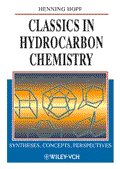
Classics in Hydrocarbon Chemistry. By Henning Hopf. Wiley-VCH: Weinheim (http://www.wiley-vch.de/cgi-bin/BD/bd.pl?bdno=vch). 2000. XIII, 547 pages. Softcover 98.- DM / 50.11 EUR / 89.- SFR ISBN 3-527-29606-9
Received: 5 July 2000

Carbon and Hydrogen: the two basic building units can be combined in a million different ways to give a plethora of fascinating organic compounds. Henning Hopf presents not only the most remarkable structures and properties of hydrocarbon compounds but shows in a clear presentation and with great didactic skill how molecules like tetrahedrane, superphane or dodecahedrane challenge the synthetic skills of every organic chemist. To make the information more accessible, especially to the novice, the author carefully analyzes the synthetic problem and explains each synthetic step and gives hints on alternative methods and potential pitfalls. Numerous references to useful reviews and the original literature make this book an indispensable source of further information. Special emphasis is placed on the skillful use of graphics and schemes: Synthetic (retro)analyses, reaction sequences, and crucial steps are presented in boxed sections within the text. Graduate students and researchers alike will find this book a gold mine of useful information essential for their daily work. Every organic chemist will want to have a copy on his or her desk.With a foreword by W. von Eggers Doering. Below is the Table of Contents:
1 -Preface -1. 2 -From Simple Building Blocks to -Complex Target Molecules and Multifaceted Reactions -5. 3 -Adamantane and other Cage Hydrocarbons -23. 3.1 -Adamantane -23. 3.2 -Higher analogs of adamantane -29. 3.3 -Twistane -30. 3.4 -Tetraasterane -34. -References -37. 4 -The Prismanes -41. 4.1 -Triprismane -42. 4.2 -[5]-Prismane -44. 4.3 -En route to hexaprismane -47 -References -50. 5 -The Platonic Hydrocarbons -53. 5.1 -Tetrahedrane -54. 5.2 -Cubane ([4]-prismane) -60. 5.3 -Dodecahedrane -63 -References -75. 6 -Bridgehead-distorted Hydrocarbons -81. 6.1 -Propellanes -82. 6.2 -Fenestranes -88. 6.3 -out,out, out,in and in,in Hydrocarbons -94 -References -99. 7 -Alkenes -1037.1 -Linear conjugated polyenes -103. 7.2 -Cyclopropene, the smallest cycloolefin and how it can be used -in hydrocarbon synthesis -112. 7.3 -Large-ring cycloalkenes by transition metal-catalyzed -oligomerization of dienes -118. 7.4 -Distorted olefins: trans-cycloalkenes, anti-Bredt-hydrocarbons, -betweenanenes, and pyramidalized olefins -122. 7.5 -Tetrakis-tert-butylethene - an exercise in preparative futility -138 -References -142. 8 -Alkynes -151. 8.1 -Polyacetylenes - rods made of carbon -151. 8.2 -Angle-strained cycloalkynes -156. 8.3 -Medium and large-ring alkynes -160 -References -165. 9 -Allenes and Cumulenes -171. 9.1 -Acyclic allenes -171. 9.2 -Acyclic cumulenes -178. 9.3 -Cyclic allenes -182. 9.4 -Cyclic cumulenes -188 -References -190. 10 -The Annulenes -197. 10.1 -1,3-Cyclobutadiene -198. 10.2 -Benzene and its isomers -203. 10.3 -Cyclooctatetraene and the (CH)8 isomers -209. 10.4 -The higher annulenes -218. 10.5 -Bridged annulenes -227 -References -238. 11 -Cross-Conjugated and Related Hydrocarbons -251. 11.1 -The dendralenes -253. 11.2 -The fulvenes -260. 11.3 -The fulvalenes -269. 11.4 -Pentalene, azulene, heptalene and other zero-bridged annulenes -277. 11.5 -The [n]radialenes -290. 11.6 -The [n]rotanes -300 -References -309. 12 -Leaving the p-Plane-Non-Planar Aromatic Compounds -32112.1 -The helicenes -323. 12.2 -The circulenes -330. 12.3 -The cyclophanes -337 -References -368. 13 -Three-dimensional Oligoolefins -379. 13.1 -Barrelene -380. 13.2 -Triptycene and the iptycenes -385. 13.3 -Bullvalene and semibullvalene -389. 13.4 -Triquinacene -397. 13.5 -Spiropolyenes, stellapolyenes and related hydrocarbons -407 -References -412. 14 -Extended Systems-I. From Benzene to -Graphite Substructures -421. 14.1 -Linearly annelated polycyclic aromatic hydrocarbons -423. 14.2 -Angularly annelated polycyclic aromatic hydrocarbons -426. 14.3 -Condensed aromatic hydrocarbons with ribbon structures -431. 14.4 -Graphite substructures -438 -References -443. 15 -Extended Systems-II. Beyond the PAH Pattern -447. 15.1 -From biphenylene to linear and angular [n]phenylenes -447. 15.2 -Extended structures containing triple bonds -457. 15.3 -Building with cyclopropane rings -472 -References -480. 16 -Classics in Hydrocarbon Synthesis- -Three Examples from Physical Organic Chemistry -48516.1 -The dehydrobenzenes -485. 16.2 -Non-Kekulé hydrocarbons -492. 16.3 -Bond fixation in benzene rings -501 -References -514 -Author Index -523 -Subject Index -527.
*Editor's Note: The brief summary and the contents of the books are reported as provided by the author or the publishers. Authors and publishers are encouraged to send review copies of their recent books of potential interest to readers of Molecules to the Editor-in-Chief (Dr. Shu-Kun Lin, MDPI, Saengergasse 25, CH-4054 Basel, Switzerland. Tel. +41 79 322 3379, Fax +41 61 302 8918, E-mail: [email protected]). Some books will be offered to the scholarly community for the purpose of preparing full-length reviews.
© 2000 by MDPI (http://www.mdpi.org).